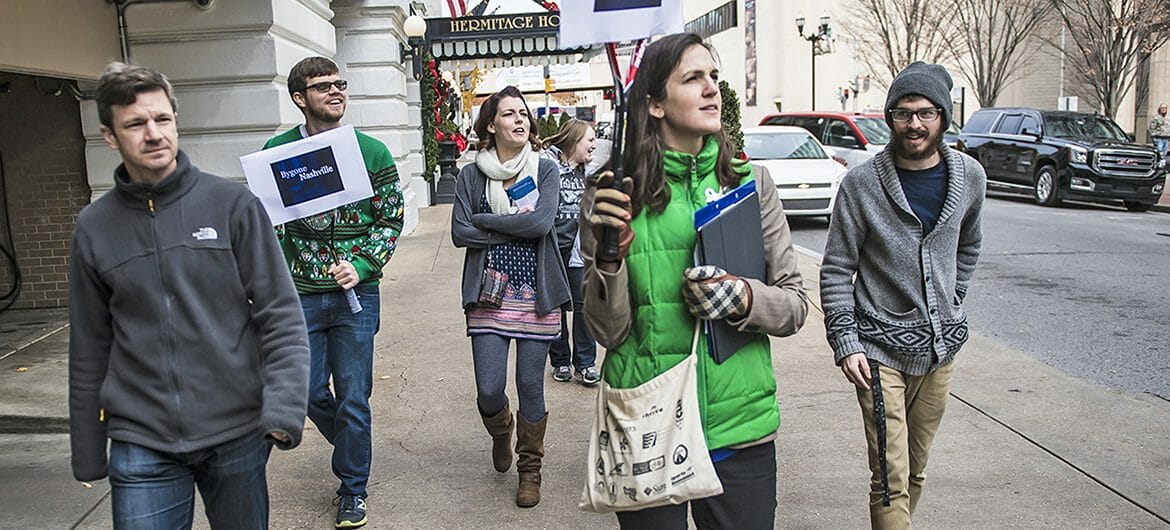History students at MTSU are making history themselves by creating a website that will enable tourists to discover Midstate history on their own.
Fifteen scholars in the fall 2017 “Doing Digital History” course taught by College of Liberal Arts assistant professor Molly Taylor-Poleskey performed archival research to create a walking tour of downtown Nashville.
“My intention is to have an iteration of this course every year in the fall,” said Taylor-Poleskey. “It’s an upper-division undergraduate course, and every course will focus on a different neighborhood of Nashville.”

Dr. Molly Taylor-Poleskey, left, MTSU assistant professor of history, and Tessa Antonelli, a junior history major from Nashville, take a break on the shoeshine chairs in the green marble men’s bathroom on the historic Hermitage Hotel’s first floor. The bathroom is open for public viewing. (Submitted photo)
Each student concentrated on a subsection of the neighborhood. They tested their work by walking their tours themselves on Dec. 6 and 11.
Features of the walking tour include the Life and Casualty Tower, the Ryman Auditorium, Fort Nashborough, Union Station, the Ernest Tubb Record Shop and the former location of Pearl School, which opened its doors to local African-Americans on what is now Fifth Avenue South in 1883.
Another stop along the way was the Hermitage Hotel, which was restored to its original 1910 splendor in the mid-1990s. The most popular historical feature of the hotel is the first-floor men’s bathroom, where the walls, toilets and urinals were made with green marble. A plaque outside the door notes that numerous legislative deals were made there.
“The men’s bathroom was voted ‘Best Bathroom of America’ by Cinta Bathroom Supply Kings,” said Amy Inthavong, a senior advertising major from Murfreesboro, who investigated the hotel’s legacy.
Bobby Cooley, a senior history major from Manchester, Tennessee, discussed an Aug. 5, 1911, publicity event to promote a car at the Tennessee State Capitol.

MTSU student Nathan Ledford, at right wearing a brown vest, shares his research from a digital tablet with fellow students inside the Ernest Tubb Record Shop at Broadway and Fourth Avenue in Nashville. Ledford is a junior history major from Cleveland, Tennessee. (MTSU photo by Eric B. Sutton)
“The salesman decided to do a demonstration of how well the new Ford Model T ran and so created a stunt to drive up the steps of the state Capitol, turn around in the inside of the building and drive it back down the steps,” said Cooley.
H.W. Major, the driver, had to drive the car up the steps in reverse because the gas line was gravity-fed, Cooley explained.
The history tour website, which is intended to be permanent and constantly updated, is not the only digital aspect of the class. Students digitally aligned satellite and aerial maps of areas with historic maps of those same areas and compared change over time in them as layers on Google Earth.
They also recorded soundscapes and produced mini-podcasts about their sites to familiarize themselves with their subneighborhoods. Taylor-Poleskey said she taught the class to emphasize adapting to constantly changing hardware and software.
“Instead of teaching how to use individual programs, which are going to be outdated in no time, I’m trying to teach them about plasticity and problem-solving when they are confronted with new technologies,” Taylor-Poleskey said.
The walking tour website is accessible at https://bygone-nashville.mtsu.edu. Updates and class photos are available at the digital history program website: www.mtsu.edu/history/digital-history.php.
You can listen to a radio interview about the tour here. For more information, contact Taylor-Poleskey at molly.taylor-poleskey@mtsu.edu.
— Gina Logue (gina.logue@mtsu.edu)

Members of MTSU’s “Doing Digital History” class leave the Hermitage Hotel in Nashville en route to their next tour stop. From left are student William Albert and assistant professor Molly Taylor-Poleskey; behind them, from left, are students Bobby Cooley and Tessa Antonelli; behind them, partially obscured, is student Victoria Hawkins. (MTSU photo by Eric B. Sutton)


COMMENTS ARE OFF THIS POST